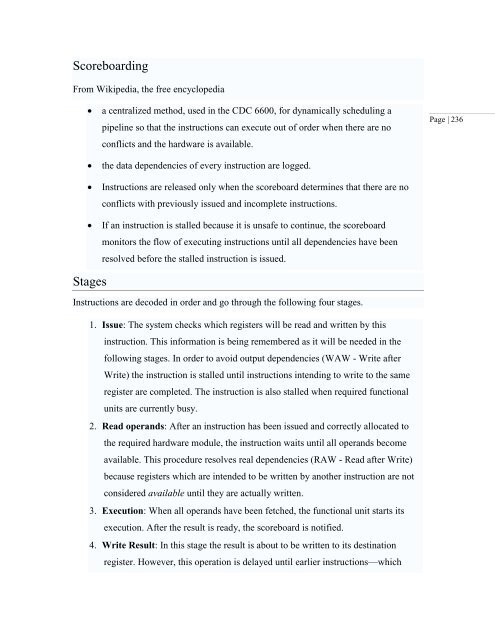- Page 1 and 2:
Page | 1 Lecture Notes for Computer
- Page 3 and 4:
knowledge given in the book chapter
- Page 5 and 6:
CS 320 SCHEDULE (tentative) Week Wh
- Page 7 and 8:
6. Project reports - Presentation C
- Page 9 and 10:
9. Course policies: 1) Satisfactory
- Page 11 and 12:
Size - keep shrinking 1994 124mm 2
- Page 13 and 14:
Families of different models - Inte
- Page 15 and 16:
Super Computers CRAY - 1 st vector
- Page 17 and 18:
Fastest super computers November 20
- Page 19 and 20:
Class Activity - 2. Trace the conte
- Page 21 and 22:
TUTOR 1.32:> PHYSICAL ADDRESS=00002
- Page 23 and 24:
TUTOR 1.32:> PHYSICAL ADDRESS=00002
- Page 25 and 26:
Class Activity 3 - Study of instruc
- Page 27 and 28:
Class Activity 4 - Study of instruc
- Page 29 and 30:
TUTOR 1.32:> PHYSICAL ADDRESS=00002
- Page 31 and 32:
TUTOR 1.32:> PHYSICAL ADDRESS=00004
- Page 33 and 34:
Performance Improvement at Instruct
- Page 35 and 36:
5. Register indirect addressing mod
- Page 37 and 38:
High Level Language Statements Ass
- Page 39 and 40:
Lecture 7 Data transfer memory reg
- Page 41 and 42:
Problem Translate HLL statement A[
- Page 43 and 44:
More MIPS instructions jump j jr $S
- Page 45 and 46:
Problem Translate the following Whi
- Page 47 and 48:
Problem Translate the following exp
- Page 49 and 50:
Problem Translate the following exp
- Page 51 and 52:
Lecture 10 Translation of High Leve
- Page 53 and 54:
Translation of Procedures Problem H
- Page 55 and 56:
Example Write the MIPS code to comp
- Page 57 and 58:
Program Counter -relative op rs rt
- Page 59 and 60:
Example Opcode always 1 byte Memory
- Page 61 and 62:
Lecture 13 Enhancing Performance at
- Page 63 and 64:
Number Systems Numbers + ve numbers
- Page 65 and 66:
Example: Design a one bit ALU with
- Page 67 and 68:
Lecture 14 - Performance Improvemen
- Page 69 and 70:
Design of Adders c 1 a n , ..., a 1
- Page 71 and 72:
Carry lookahead adder Problem with
- Page 73 and 74:
Another look at CLA xi + yi = Pi xi
- Page 75 and 76:
4-bit CLA Page | 75 generates C3 ge
- Page 77 and 78:
Lecture 15 Performance Improvement
- Page 79 and 80:
Example 981 X 1234 0981 X 1234 mult
- Page 81 and 82:
Example Consider the multiplication
- Page 83 and 84:
2 nd version Reduce cost by reducin
- Page 85 and 86:
4th step 4 bits registers 0010 4 bi
- Page 87 and 88:
0010 ADDER Page | 87 0001 0010 ADDE
- Page 89 and 90:
2's complement of m'cand 1111110101
- Page 91 and 92:
0010 ADDER Page | 91 1111 0001 1 no
- Page 93 and 94:
Lecture 16 - Performance Improvemen
- Page 95 and 96:
Hardware units needed to perform th
- Page 97 and 98:
Step 1 Rem = Rem - Divisor ( this t
- Page 99 and 100:
5th step Rem = Rem - Divisor Now Re
- Page 101 and 102:
2nd step Shift remainder left Rem =
- Page 103 and 104:
3 rd version of Division algorithm
- Page 105 and 106:
Step 3 Rem = Rem - Div Rem > 0 Shif
- Page 107 and 108:
Normalized Form keeps one digit lef
- Page 109 and 110:
Let us consider the addition of two
- Page 111 and 112:
Control path Inputs Exponent differ
- Page 113 and 114:
Lecture 19 Architectures for Crypto
- Page 115 and 116:
1. Following pseudo code represents
- Page 117 and 118:
Find 7 36 mod 11 using right to lef
- Page 119 and 120:
Lecture 20 - Performance Chapter -
- Page 121 and 122:
total amount of work done in a give
- Page 123 and 124:
Question 4 Assuming the CPI for pro
- Page 125 and 126:
Question 9 Yet another user has the
- Page 127 and 128:
Question 12 Assuming the CPI values
- Page 129 and 130:
Use C2 CPI on M1 = 4*0.3+6*0.2+8*0.
- Page 131 and 132:
Question 15 We are interested in tw
- Page 133 and 134:
Question 18 You are the lead design
- Page 135 and 136:
Arithmetic Logic unit Register file
- Page 137 and 138:
Lecture 22 - Processor Design - Dat
- Page 139 and 140:
Example Design the data path to fet
- Page 141 and 142:
Now combine two functional units to
- Page 143 and 144:
Lecture 23 Processor Design - Data
- Page 145 and 146:
Example : - Design DataPath for SW
- Page 147 and 148:
Processor Design - Data path for R&
- Page 149 and 150:
Example : - Implement R+ I +J Forma
- Page 151 and 152:
31 26 0 4 control signals EX/Addres
- Page 153 and 154:
Draw the logic circuit _ _ _ _ _ _
- Page 155 and 156:
Single cycle implementation of the
- Page 157 and 158:
from Aluop B from output PC Data Ad
- Page 159 and 160:
Lecture 27 High level view of the F
- Page 161 and 162:
0 Page | 161 1 2 3 5 4 0 - MemRead
- Page 163 and 164:
FSM Controller for lw/sw 6 states 0
- Page 165 and 166:
Lecture 28 R-type instruction conti
- Page 167 and 168:
Branch Instruction Fetch Page | 167
- Page 169 and 170:
Jump Inst Fetch Page | 169 Inst dec
- Page 171 and 172:
Page | 171
- Page 173 and 174:
0 1 Page | 173 2 6 8 9 3 5 7 4 op 0
- Page 175 and 176:
NS0 = 1 + 3 + 5 + 7 + 9 NS1 = 2 + 3
- Page 177 and 178:
Lecture 30 Microprogramming - FSM c
- Page 179 and 180:
- Microinstruction placed in a ROM
- Page 181 and 182:
- In multicycle design - assume tha
- Page 183 and 184:
Multi-cycle implementation of the M
- Page 185 and 186: 2.5 Draw the functional units neces
- Page 187 and 188: 2.9 The instruction, addi (add imme
- Page 189 and 190: Problems with pipelining Hazards Da
- Page 191 and 192: Ex: Represent the 5 stage pipeline
- Page 193 and 194: Example Represent the 5 stage pipel
- Page 195 and 196: Example: Find the size of each pipe
- Page 197 and 198: Pipelined control path - Single cyc
- Page 199 and 200: Control signals with instructions E
- Page 201 and 202: Ex: Show the control signals genera
- Page 203 and 204: Ex: Show the control signals genera
- Page 205 and 206: Lecture 33 Forwarding Unit Design E
- Page 207 and 208: Example: Illustrate the forwarding
- Page 209 and 210: Design a Forwarding unit to integra
- Page 211 and 212: Ex: Forwarding with 2 inst. (1) add
- Page 213 and 214: Lecture 34 Data hazard and stalls F
- Page 215 and 216: Tomasulo • Lasting Contributions
- Page 217 and 218: Tomasulo Organization Page | 217
- Page 219 and 220: 4. Show the pipeline execution of f
- Page 221 and 222: 7. Illustrate the pipelined data pa
- Page 223 and 224: 11. Reorder the following instructi
- Page 225 and 226: 15. Design the forwarding unit for
- Page 227 and 228: Temporal locality Low Data Accessin
- Page 229 and 230: Associative mapping More flexible m
- Page 231 and 232: Problems 1. Here is a series of add
- Page 233 and 234: 6. What are the miss rate of the fo
- Page 235: Installation and Usage of Maxplus I
- Page 239 and 240: Tomasulo hardware algorithm From Wi
- Page 241: When all operands are available o I
















